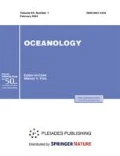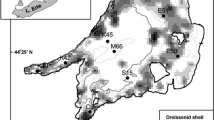Abstract—
The potential productivity of oysters and mussels was estimated for Voevoda Bay (Russky Island, Primorskii krai) using the FARM model. The main sources of primary production in the study area are seagrass (Zostera marina) and phytoplankton (diatoms). The area of Zostera growth was delineated based on the bottom survey of the bay. The parameters of organic matter production of Zostera and phytoplankton for each computational grid cell were modeled using the ECO BLOOM II Algae module, which is part of the DELWAQ model of the Delft3D software package. Spatial redistribution of organic matter, chlorophyll a and phytoplankton were simulated using the results of hydrodynamic modelling of the DELFT3D Flow. The values of biological (primary production) and hydrochemical (temperature, salinity, oxygen content) parameters, obtained for each computational grid cell were used as input to the FARM. The empirical exceedance probability curves of modelled productivity for pasture and cage cultivation of the giant oyster (Crassostrea gigas) and the Pacific mussel (Mytilus trossulus) were calculated for each cell. The spatial distribution for the potential productivity values of the representative exceedance probability (50, 75, and 95%) for both types of cultivation was mapped.




Similar content being viewed by others
REFERENCES
A Report on Ecological Situation in Primorskii Krai in 2018 (Administration of Primorskii Krai, Vladivostok, 2019) [in Russian].
L. S. Afeichuk and N. D. Mokretsova, “Biological principles of cultivation of Pacific blue mussel (Mytilus trossulus) in the open waters of the Peter the Great Bay,” Izv. Tikhookean. Nauchno-Issled. Inst. Rybn. Khoz. Okeanogr. 127, 642–656 (2000).
Yu. A. Barabanshchikov, P. Ya. Tishchenko, P. Yu. Semkin, et al., “Seasonal hydrological and hydrochemical surveys in the Voevoda Bay (Amur Bay, the Sea of Japan),” Izv. Tikhookean. Nauchno-Issled. Inst. Rybn. Khoz. Okeanogr. 180, 161–178 (2015). https://doi.org/10.26428/1606-9919-2015-180-161-178
Yu. E. Bregman, “Bioenergetics of trophic chains mollusk–filter–feeding bivalve–sea cucumber–detritophage in conditions of bioculture,” Izv. Tikhookean. Nauchno-Issled. Inst. Rybn. Khoz. Okeanogr. 113, 5–12 (1994).
D. I. Vyshkvartsev, Candidate’s Dissertation in Biology (Vladivostok, 1979).
G. S. Gavrilova, Doctoral Dissertation in Biology (TINRO Center, Vladivostok, 2012).
G. S. Gavrilova, “Current state and problems of development of Far Eastern mariculture,” Proceedings of the VIII All-Russian Scientific-Practical Conf. Dedicated to the 75th Anniversary of Fishery Industry in Kamchatka “Nature Resources: Modern State, Protection, Commercial and Tehcnical Use” (Petropavlovsk-Kamchatskiy, 2017), pp. 68–71.
G. S. Gavrilova and A. V. Kucheryavenko, Productivity of Plantations of Bivalvia Mollusks in Primorye (TINRO Center, Vladivostok, 2011) [in Russian]. https://rucont. ru/efd/278345.
E. A. Gaivan, S. P. Zemtsov, and A. A. Mazurova, Mariculture of Primorskii Krai: Development Potential of the Industry within the Aquatic Territorial Systems of the Region (LAP LAMBERT Academic, Saarbrucken, 2012) [in Russian].
R. A. Deeva, Catalogue of Harmonic and Non-Harmonic Constant Tides of the National Far Eastern Seas (Gidrometeoizdat, Leningrad, 1972) [in Russian].
A. V. Kucheryavenko and A. P. Zhuk, Guide for Cage and Bottom Cultivation of the Scallop (TINRO Center, Vladivostok, 2011) [in Russian].
A. V. Kucheryavenko and A. P. Zhuk, Guide for Cultivation of the Pacific Oyster (TINRO Center, Vladivostok, 2011) [in Russian].
A. F. Karpevich, “Potential properties of hydrobionts and their implementation in aquaculture,” in Biological Principles of Mariculture (VNIRO, Moscow, 1998), pp. 78–100.
S. V. Katrasov, A. N. Bugaets, V. V. Zharikov, et al., “Site selection for marine aquaculture using hydrodynamic simulation,” Oceanology (Engl. Transl.) 61, 380–389 (2021).
A. I. Kafanov, Bivalve Mollusks of the Shelf and Continental Slope of the Northern Pacific: Annotated Index (Far Eastern Branch, Academy of Sciences of USSR, Vladivostok, 1991) [in Russian].
Navigation of the Northwestern Coast of the Sea of Japan from the Tumannaya River to Cape Belkin (Directorate for Navigation and Oceanography, Leningrad, 1984) [in Russian].
Candidate’s Dissertation in Biology (Far Eastern Scientific Center, Academy of Sciences of USSR, Vladivostok, 1985).
S. A. Lyashenko, “Features of Mytilus trossulus reproduction in the Voevoda Bay (Russky Island),” Izv. Tikhookean. Nauchno-Issled. Inst. Rybn. Khoz. Okeanogr. 140, 352–365 (2005).
Dzh. Kh. MakDonal’d, R. K. Kouen, E. S. Balakirev, et al., “Species affiliation of the “edible mussel” inhabiting the Asian part of the Pacific Ocean,” Biol. Morya (Vladivostok), No. 1, 13–22 (1990).
Sectoral Program “Development of Commercial Aquaculture (Commercial Fish Farming) in the Russian Federation for 2015–2020” (Moscow, 2014) [in Russian].
N. I. Selin, “Dynamics of habitats of Pacific mussel in the southern Primorye,” Biol. Morya (Vladivostok), No. 4, 68–69 (1990).
O. A. Skarlato, Guides for Identification of Fauna of the USSR, No. 126: Bivalve Mollusks in the Moderate Altitudes of the Western Part of the Pacific Ocean (Nauka, Leningrad, 1981) [in Russian],
D. A. Sokolenko and M. V. Kalinina, “Current state and structure of natural habitats of the Pacific oyster in the northern part of the Amur Bay (the Peter the Great Bay, Sea of Japan),” Izv. Tikhookean. Nauchno-Issled. Inst. Rybn. Khoz. Okeanogr. 195, 48–60 (2018).
The Development Strategy of Aquaculture in Russian Federation until 2020 (Ministry of Agriculture of Russia, Moscow, 2007) [in Russian].
The Development Strategy of Fishery Industry of Russian Federation until 2030 (Rosinformagrotekh, Moscow, 2019) [in Russian].
A. V. Suprunovich, Aquaculture of Invertebrates (Naukova Dumka, Kiev, 1988) [in Russian].
A. V. Suprunovich and Yu. N. Makarov, Cultivated Invertebrates. Food Invertebrates: Mussels, Oysters, Scallops, Crayfish, and Shrimps (Naukova Dumka, Kyiv, 1990) [in Russian].
Cultivation of scallop in Primorye, ESIMO portal, Version 1.6.8, 1999–2020. http://portal.esimo.ferhri.ru/ portal/portal/poi/japan/pacificKISWindowJapan. Accessed April 20, 2020.
Yu. M. Yakovlev, V. A. Rakov, and L. V. Dolgov, “Reproduction and development of the Pacific oyster Crassostrea gigas Thunb.,” in Fouling Organisms from Far Eastern Seas (Far Eastern Scientific Center, Academy of Sciences of USSR, Vladivostok, 1981), pp. 79–93.
A. N. Blauw, H. F. J. Los, M. Bokhorst, and P. L. A. Erftemeijer, “GEM: a generic ecological model for estuaries and coastal waters,” Hydrobiologia 618, 175–198 (2009).
A. N. Bugaets, L. V. Gonchukov, O. V. Sokolov, et al., “Information system to support regional hydrological monitoring and forecasting,” Water Resour. 45, S59–S66 (2018).
H. Carr and L. Axelsson, “Photosynthetic utilization of bicarbonate in Zostera marina is reduced by inhibitors of mitochondrial ATPase and electron transport,” Plant Physiol. 147 (2), 879–885 (2008). https://doi.org/10.1104/pp.107.115584
D-Water Quality Technical Reference Manual, 4th ed. (Deltares, Delft, 2013).
J. G. Ferreira, A. J. S. Hawkins, P. Monteiro, et al., “Integrated assessment of ecosystem-scale carrying capacity in shellfish growing areas,” Aquaculture 275 (1–4), 138–151 (2008). https://doi.org/10.1016/j.aquaculture.2007.12.018
J. G. Ferreira, A. J. S. Hawkins, and S. B. Bricker, “Management of productivity, environmental effects and profitability of shellfish aquaculture—the Farm Aquaculture Resource Management (FARM) model,” Aquaculture 264, 160–174 (2007).
A. Gangnery, C. Bacher, and D. Buestel, “Assessing the production and the impact of cultivated oysters in the Thau lagoon (Méditerranée, France) with a population dynamics model,” Can. J. Fish Aquat. Sci. 58, 1–9 (2001).
F. J. Los and J. W. M. Wijsman, “Application of a validated primary production model (BLOOM) as a screening tool for marine, coastal and transitional waters,” J. Mar. Syst. 64, 201–215 (2007).
F. Los, Eco-Hydrodynamic Modeling of Primary Production in Coastal Waters and Lakes Using BLOOM (IOS Press. Amsterdam, 2009).
C. W. McKindsey, H. Thetmeyer, T. Landry, and W. Silvert, “Review of recent carrying capacity models for bivalve culture and recommendations for research and management,” Aquaculture. 261 (2), 451–462 (2006). https://doi.org/10.1016/j.aquaculture.2006.06.044
C. R. Newell and J. R. Richardson, “Shellfish carrying capacity and site optimization,” Aquac. Irel. 115, 15–19 (2004).
J. P. Nunes, J. G. Ferreira, F. Gazeau, et al., “A model for sustainable management of shellfish polyculture in coastal bays,” Aquaculture 219 (1–4), 257–277 (2003).
C. Silva, J. G. Ferreira, S. B. Bricker, et al., “Site selection for shellfish aquaculture by means of GIS and farm-scale models, with an emphasis on data-poor environments,” Aquaculture. 318, 444–457 (2011).
R. Väinölä and P. Strelkov, “Mytilus trossulus in northern Europe,” Mar. Biol. 158 (4), 817–833 (2011).
Funding
This work was carried out with partial financial support from the Russian Foundation for Basic Research (project no. 20-05-00381-a) and the Russian Science Foundation (project no. 21-74-30004).
Author information
Authors and Affiliations
Corresponding author
Ethics declarations
Conflict of interests. The authors declare that they have no conflict of interest.
Statement on the welfare of animals. All applicable international, national, and/or institutional guidelines for the care and use of animals were followed.
Additional information
Translated by V. Mittova
Rights and permissions
About this article
Cite this article
Katrasov, S.V., Bugaets, A.N., Zharikov, V.V. et al. Estimation of Bivalve Mollusk Plantation Productivity Based on Simulation Results. Oceanology 61, 668–676 (2021). https://doi.org/10.1134/S0001437021050064
Received:
Revised:
Accepted:
Published:
Issue Date:
DOI: https://doi.org/10.1134/S0001437021050064




